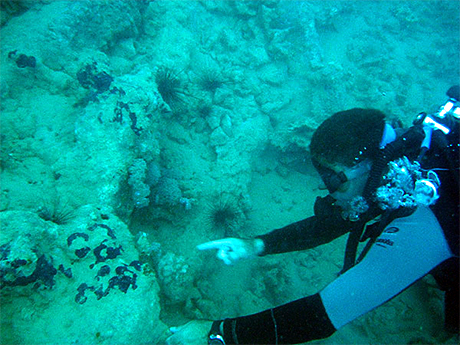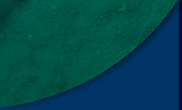
The First Dive
20 November 2008
By Mike Krivor
Today is our first day to dive the wreck site thought to be the Serapis. We have loaded our SCUBA equipment aboard the 22-foot dive vessel operated by Maximo, an Italian who has made Ile. St Marie his home for the past 16 years. Although the weather is intermittent with a steady wind out of the south we decide to attempt a dive on the wreck. We will all dive together as a group with Maximo as our guide. He has been on the site numerous times and is familiar with its orientation. All of us don our SCUBA equipment and proceed to the down line which will take us to the wreck. Maximo tells us we will drop down on a large anchor at which point we will head due south 40 feet to the wreck. As we descend I am pleased that conditions are favorable with decent visibility (approximately 20 feet) and no noticeable current.

Possible lead ballast bars found on wreck.
As we approach the bottom at 65 feet the first object that comes into view is a large, folding stock anchor sitting upright on the sea floor. The fact that the anchor has a folding iron stock indicates it is more modern than the Serapis... not a good sign. We don't spend any time examining the anchor and instead proceed south across the sea floor to the wreck site. Then, the wreck comes into view. At first glance it appears as a large coral outcrop, rising maybe 8-10 feet off the bottom. But as you get closer it is clear it is in fact the remains of a sizeable shipwreck, oriented approximately east/west.
The first noticeable artifact associated with the wreck is a massive anchor, laying along the north face of the wreck. This anchor is different from the first. It has no folding iron stock which indicates it is older, likely dating to the 18th century. The sharp angle of the crown of the anchor also infers it dates to the 18th century. Excited, we all then follow Maximo up onto the wreck...
The next objects that come into view are a number of large iron cannon jumbled amongst the coral. It is hard to keep track how many there are so I stop counting. We will get a more accurate count later. Maximo takes us immediately to a large square box perched on top of the wreck. It is approximately 4-5 feet square and rises off the wreck maybe 2 feet. Proceeding west we pass over small ballast stones and then a series of oblong objects. Maximo gathers us around and we look closer. These are either lead or iron ingots likely used as ballast and to help in trim the ship prior to a voyage. This is also exciting and another indicator of an 18th century shipwreck.
Maximo continues to guide us around the wreck showing us a variety of diagnostic material including glass bottle bases and ceramic pieces. Perhaps the most intriguing is a sizeable run of copper sheathing along the northeast extent of the wreck. Copper sheathing was employed after the 1740s and remained in practice until the mid-19th century. Historical records indicate the Serapis was indeed sheathed in copper.
While we only spent 30 minutes on the wreck I notice we are all smiling aboard the dive vessel as we head back to port. Although it is too early to call this wreck the Serapis, there is nothing on the site to indicate it is not.
Please feel free to contact us at mua@keimaps.com with any comments, questions, or suggestions during the weeks to come.
Return to Project Journal home page.


